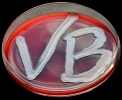| Species/Subspecies: | Dichelobacter nodosus | ||||||||
|---|---|---|---|---|---|---|---|---|---|
| Categories: | Motile; notifiable diseases and bacteria | ||||||||
| Etymology: | Genus name: rod shaped (bacterium) in ungulates. Species epithet: full of knots (refers to the shape of the cells). | ||||||||
| Significance: | The disease causes economic losses and animal suffering in large parts of the world. [Very important] |
||||||||
| Alternative Species Name(s): | Bacteroides nodosus | ||||||||
| Taxonomy: | Class Gammaproteobacteria Order Cardiobacteriales Family Cardiobacteriaceae Genus Dichelobacter |
||||||||
| Type Strain: | ATCC 25549 = CCUG 27824. | ||||||||
| Macromorphology (smell):
| Small (0.5-3.0 mm in diameter) translucent grayish white colonies after 3-7 days. Grows slowly and the colonies are difficult to see. Gives no hemolysis on FAA plates. | ||||||||
| Micromorphology:
| Straight or curved rods (1-1.7 x 3-6 µm) with rounded and enlarged ends. Has twitching motility by means of type IV pili. | ||||||||
| Gram +/Gram -: | G- | ||||||||
| Metabolism: | Strictly anaerobic | ||||||||
| Catalase/Oxidase: | -/- | ||||||||
| Other Enzymes: | DNase -, esculinase -, ornithine decarboxylase +, tryptophanase (indole) -, urease -. | ||||||||
| Biochemical Tests: | H2S + | ||||||||
| Fermentation of carbohydrates: | D. nodosus does not ferment carbohydrates. | ||||||||
| Spec. Char.: | |||||||||
| Special Media: | Hoof agar is often used for isolation of D. nodosus. | ||||||||
| Disease: |
|
||||||||
| Virulence Factors: | Type IV pili (fimbriae) which give the bacteria motility in damaged tissue. Extracellular serine protease which makes it possible for the bacterium to digest the tissue of the host animal to get access to free amino acids. | ||||||||
| Diagnostics: | Gram staining of clinical material, microscopy, culture and confirmation by PCR or MALDI-TOF MS. Benign strains can be differentiated from virulent ones by PCR. | ||||||||
| Genome Sequence: |
|
||||||||
| 16S rRNA Seq.: |
| ||||||||
| Taxonomy/phylogeny:
|
Only one species has been described within genus Dichelobacter and this species is related to species within genus Stenotrophomonas. | ||||||||
| Legislation: | Dichelobacter nodosus in laboratory diagnosis is a notifiable disease in Sweden | ||||||||
| Reference(s): | No. 2, 39, 127 | ||||||||
| Updated: | 2024-11-15 |
